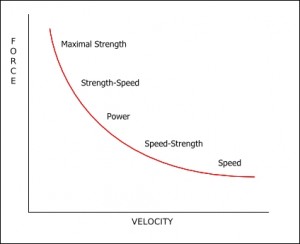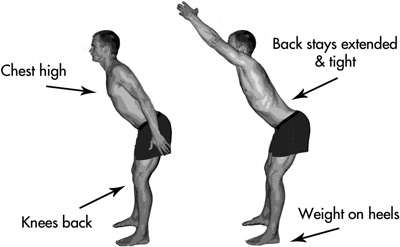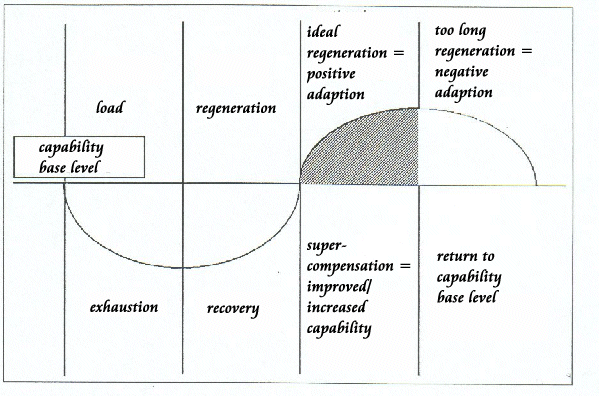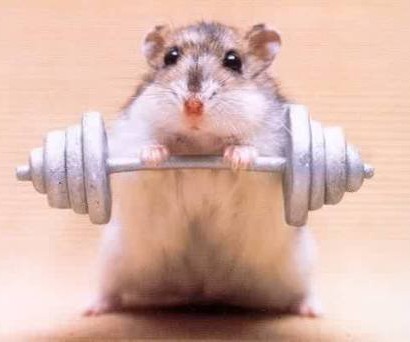I realized I’ve been talking about what everyone else should or could do, without much talk about how I apply these principles to my own situation. Therefore, I decided to put up a training log from the last several months. This is what I have been up to since I wrote a year-long “program” for myself in order to better stay on track and focus on the right areas at the right times. This all started somewhere around the end of November, early December with some GPP work, then I progressed to weeks of hypertrophy, during which I actually FINALLY grew some visible leg muscles. From there I went to strict strength training, where I am now, which is a third cycle of Jim Wendler’s 531 program supplemented by various strongman lifts. At the end of this cycle, I will transition to a more power oriented program design, and then to an in-season maintenance design in the Fall. I’m still looking for my GPP and hypertrophy logs so I can put them in at the beginning of this page.
5/13/2013: box jumps 3×5 @ BW; KB swings 1×10 @25, 1×10@35; power cleans 4×3 @ 89, 1×3 @ 100; push press 3×5 @ 89; board press 3×5 @ 135; rev sled drags 3 laps @ 3x45plates
Transitioning to more power oriented programming.
5/9/2013: still recovering: OH press 531 up to 90×10; DL 531 up to 245×8; incline axle press 2×10 @ 79; front squat 2×10 @ 89
5/6/2013: various injuries from rugby prevented full workouts this week: bench 531 up to 130×8; squat 531 up to 180×7
5/3/2013: DL 531 up to 232×7; sandbag carries from ground 5laps @ 100; side lunges 1×10 @ 25; glute-ham 1×7@ 15; lunges 1×10@BW
5/2/2013: OH press 531 up to 85×10; KB cleans 3x4ea @ 50; BB row 3×8@111; pushups 3×5 @ BW+45; pulldowns 3×8 @#10
4/30/2013: squat 531 up to 170×8; atlas stones warmup 106×3, 44″ platform, 150stone x3, 175 stone x 3; BB split squat 3×10 @ 67#; leg press 1×10 @ 200, 3×5 @ 250
4/29/2013: bench 531 up to 125×10; KB cleans 3×4 @ 50; cable rows 3×9 @ #11+2.5; incline axle press 3×10@ 80; skullcrushers 3×10 @ 25; 1A DB row 3×9@ 50
4/27/2013: DL 531 up to 220×7 (groin acting up still); front squat 2×10 @ 67; tire flips 3×3 @ 450
4/26/2013: OH press 531 up to 80×11; KB cleans 2×4@35, 1×4@50; pushups 1×10@ BW+22, 2×5@BW +44; NG pulldowns3x8@#11; dragonflags 2×4 @ BW; rev crunches; anti-rotation planks 2x 20
4/24/2013: squat 531 unable to finish due to R groin strain previous night at rugby practice – did 140×5 before stopping; yoke walk 1x80ft at 250, 300, 340, 350
4/23/2013: bench 531 up to 115×10; KB cleans 3x4ea @ 35; BB press2x10 @ 45; pullups x40@BW; 1A DB OH press 3×10 @ 40; battle ropes 3x30s, 1min rest
4/18/2013: recovery week – light OH press, light DLs, some pullups, pushups, glute ham raises
4/16/2013: recovery week – light bench, light squats, some incline bench, BO BB rows, good mornings, side lunges
4/12/2013: OH press 531 up to 85.5×10; DL 531 up to 238×7; 1A DB row 2×10@45, 2×10 @ 50; side lunges 3x10ea @ 20; jump rope 3x1min/30s rest
4/9/2013: squat 531 up to 170×10; BB split squat 3x8ea @ 72; atlas stones 3×5 reps @ 106# stone, 48” shelf
4/8/2013: bench 531 up to 125×10; log push press 3×10 @ 78; DB rev fly 3×8 @ 15; battle ropes 3x30sec/30s rest – had to stop due to elbow issues this day
4/5/2013: DL 531 up to 220×7; sandbag carry laps x 7 @ 100# from ground; leg press 2×10 @ 200, 1×4 @ 290
4/4/2013: OH Press 531 up to 80×10; BB rows 2×10 @ 95, 1×10@ 105; 1A DB OH press 3x9ea. @ 40; pulldowns 3×10 @ #10.5
4/2/2013: squat 531 up to 160×10; farmer carry 220×2 no release, 300 x1 release, 320×2 release; rev hypers 3×10 @ BW
4/1/2013: bench press 531 up to 120×12; pullups x35 @ BW; pushups 3×10 @ BW+5; jump rope 3×1 min on/30s off
3/28/2013: DL 531 up to 210×8; front squat 3×7 @ 111; speed tire flips125# tire 4×10 flips, 1 min rest between sets
3/27/2013: OH Press 531 up to 75×12; wide NG lat pulldowns 3×10 @ #10; narrow NG cable rows 3×8 @ #11; 1A DB rev flys 3x10ea. @ 10#; dragonflags 2×5; 1L bent knee hip ext 2x10ea.
3/26/2013: squat 531 up to 150×8; yoke walk 80ft 1×250, 1×290, 1×340, 2×320; glute-ham 3×10 @ BW+15; rugby practice
3/25/2013: bench press 531 up to 110×12; pullups x30 @ BW; pushups 3×10 @ BW, battle ropes 5x30s on/1min rest
3/22/2013: deload week: some light lower body work: squats, deadlift
3/20/2013: deload week: some light upper body work: bench press, OH press, BO log row, DB rev fly, lat pulldowns
3/15/2013: DL 531 up to 224×4, 243×1, 265×1, 281.5×1; DB lunges 3x9ea @ 25#; assist. 1L squat 3x5ea @ BW; physio ball pike 2×12; side stars 2x30s ea.; treadmill nonsense 13′
3/14/2013: OH press 531 up to 80×10, 95×1, 110×1; 1A inverted row 3×10@ BW; floor DB OH press 3×10 @ 30; lat pulldowns 2×10 @ #10; DB fly 2×10@ 20
3/13/2013: squat 531 up to 160×8, 190×1, 220×1; BB split sq 3x8ea @ 78; glute-ham raises 3×10@ BW+11
3/12/2013: bench press 531 up to 120×12, 135×1, 155×1, 165×1; pullups BW x35; 1A incline pushups level #12 2×8, level 11 1x6ea.; 1A DB row 3×8 @45; 1A DB OH press 3×8 @40; 1A DB rev flys 2×10 @ 8; roman chair 2×10 @ BW+5; hanging leg swing 1×10
3/9/2013: DL 531 up to 215×6, 248×1, 270.5×1; front squats 3×10@100; 1 hr massage hell yea
3/6/2013: OH press 531 up to 75×12, 89×1, 104.5×1; seated cable rows wide bar 3×10@#10; floor seated DB OH press 3×10@ 25; DB bench press 2×10 @ 45; physio ball pikes 3×10. pretty much sucked at life at the gym today. Woo.
3/5/2013: squat 531 up to 150×10, 177×1, 210×1; BB static split squat 3×10 @67; good mornings 3×10 @56; leg press 2×10 @200; 1L rev hypers 10@BW; 1L DL 2×5 @30#; dragonflagx5; 1L leg raises 2×16@BW
3/4/2013: bench press 531 up to 115×12, 135×1, 155×1; 1A incline pushups 3x6ea.; 1A DB press 3×10 @ 35; cable face pulls 3×10 #3; BW pullups x 30; roman chair BW 2×8
3/1/2013: DL 531 up to 6@200, 1×248, 1×259; front squat 2×10@ 100; 1L squat 2x5ea. BW; rev hypers 2×10 BW; curtsy lunges 2×10 BW
2/28/2013: OH press 531 up to 75×11, 97×1, 102×1; 3×10 of assist. pullups @ or. band plus; 1A landmine press @89; wide bar NG seated rows @ #10; 5 dragonflags; 10 physio ball pikes; 1×10 BW pullups
2/26/2013: squat 531 up to 145×10, 176×1, 200×1; 3×10 of glute ham raises @ BW+10, BB static split squats @ 67, good mornings @ 45; tred sled 3x20s
2/25/2013: bench press 5/3/1 up to 110×12; 3×10 of assist. pullups @ or. band, knuckle pushups @ BW, 1A DB rows @ 40#, 1A DB press @ 30#, DB rev fly @ 15#; jump rope 2x3min
2/21/2013: sled drags 5xlap @ 160; sandbag carries 3xlap @ 160 & 2x2laps @ 110; band resisted side shuffling 4x5ea.; 4 cone drill 4x20s; treadmill jog @ 4.0 inc incline every min from 0-10.0 then my feet went numb 🙁
2/20/2013: Find 5 rep maxes: OH press 90; DL 234 (only because Hans yelled at me the whole time). 4 rounds jump rope
2/19/2013: Deload week: find 5 rep maxes: bench 125; squat 166. various light exercises; 3 tred sled
2/14/2013: supine med ball throws 3×10 @ 6; BB OH press 3×12 @ 61; assist. pullups 3×10 or. band; BO log row 3×10 @ 95; battle ropes w alt rev lunge 4xHR ranges (170-140)
2/13/2013: warmup: banded side lunges 3x10ea. or. band; then squats 3×8-12 @ 144; glute-ham raises 3×10 @ BW+8; side lunges 3x10ea. @ BW+25; 1×10 angled roll outs small wheel; 1x30s ea. side star plank; 1×15 leg raises; 1×10 plank touches; tire flips 1×1/1/2/3 @ 450# tire
2/11/2013: yoke walk 80ft @ 1×250, 2×300; bench press 3×8 @ 115; incline axle press 3×10 @ 85; assist. dips 3×7 or. band; treadmill push sprints 5x20s on/20s off
2/8/2013: warmup: banded side lunges 3x7ea. or. band; then DL 3×8-12 @ 177; front squats 3×10 @ 78; alt lunges 3x10ea. @ BW+30
2/7/2013: warmup: power cleans 3×4 @89; then OH BB press 3×8-12 @ 55, assist. pullups w med. orange band 3×10; 1/2 kneel landmine press 3x7ea. @ 89, 1A DB BO row 3x7ea. @ 35; calf raises off step 3×15 @ BW+30; sandbag runs 3x2laps @ 105# bag
2/5/2013: warmup: box jumps 3×6 @ BW; then atlas stones 4×1 @ 150 to 44″platform; squats 3×10-12 @ 133; glute-ham raises 3×10 BW+8; side lunges 3×10 BW+25; roll outs small wheel 3×10 @ BW
2/4/2013: warmup: power cleans 3×4 @78; then farmer’s carry 4xlaps @ 320; flat bench 3×12 @ 95; circuit of 3×10 incline axle press @ 55, 3×10 BO log row @ 111, 3x1min jump rope; tricep rope pull downs 3×10 @?
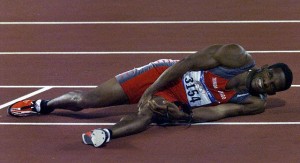
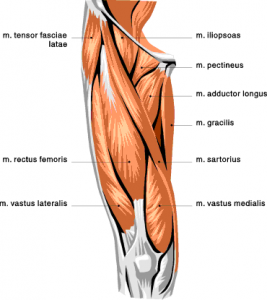 It is hard to distinguish on oneself because it is difficult to both resist and assess the parts you are checking at the same time. Also, the injury was located up by the proximal (near) tendon, not down in the muscle belly or by the knee. Since the rectus femoris and sartorius muscles have similar functions, it is not really necessary for rehab purposes to distinguish further. Either way, moving my right leg made me very unhappy. 🙁
It is hard to distinguish on oneself because it is difficult to both resist and assess the parts you are checking at the same time. Also, the injury was located up by the proximal (near) tendon, not down in the muscle belly or by the knee. Since the rectus femoris and sartorius muscles have similar functions, it is not really necessary for rehab purposes to distinguish further. Either way, moving my right leg made me very unhappy. 🙁

